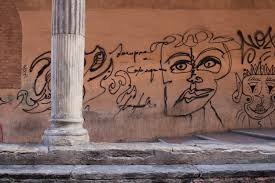Vandalism or Value: Bologna’s Street Art Debate
Words by Ella Gauci
Bologna, Italy
From an aerial perspective of Bologna - Italy’s food capital - the old city is a terracotta wonder. It appears almost so perfect it could be a miniature reconstruction of a city. But on street level, there is a fascinating story that lies on these orange painted walls.
Graffiti.
The city is covered in it.
From hurried spray paint tags to glorious murals, the city’s porticos are covered in a story that goes beyond just the street art itself. With a very present student population, graffiti in Bologna appears to be a representation of the youth and vitality that is infiltrating the city. The famous street artist Blu once covered the city with his murals which spanned whole buildings, revitalising the ancient city. Below you can see his homage to pop culture, with a mural inspired by Lord of the Rings among other pop culture references.
One of Blu’s murals covering an entire wall
But, as with a lot of street art, there are rampant critics. The most notable one being the mayor of Bologna, Virginio Merola, who began a campaign in 2015 to crack down on what he described as “graphic vandalism” of the city due to the graffiti being produced. In direct retaliation, Blu took down or painted over the entirety of his work in Bologna claiming that ‘There’s no more Blu in Bologna’.
The removal of Blu’s mural
Blu’s decision to remove his own street art raises an important debate about the place of graffiti in both a physical and social sense. He took direct issue with the notion of street art as vandalism, especially when the city later hosted an event celebrating ‘legitimate’ street art. The commodification and regulation of something which is (by nature) a spontaneous act of an individual seemed like an empty gesture in the hopes of rebranding the city.
However, while Blu’s political statement is pertinent and discursive, the question of what should be defined as ‘street art’ also must be thrown into question. Graffiti and street art are often conflated with each other and pushed into the same category. While graffiti is a means of self expression, street art often aims to appease the masses and is generally commissioned by a local council. Graffiti is also often associated with a more urgent political agenda; seen as a tool for those who feel largely voiceless.
Tagging in Bologna
What Virginio Merola was probably referring to when discussing the ‘vandalism’ of the city was the sheer amount of tagging that takes place on its walls. Tagging is often used by graffiti artists to mark their territory and is largely done illegally. When I first walked into the city, it became evident that I would struggle to find a street without graffiti tags on either side of me. In the mornings and evenings you can see shop owners and residents repainting their walls to get rid of the marks.
Is Blu right to defend illegal street art or graffiti? For me, I think he is instead defending a principle. You cannot criminalise street art that does appeal not to you and in the same breath try to celebrate its more palatable works.




